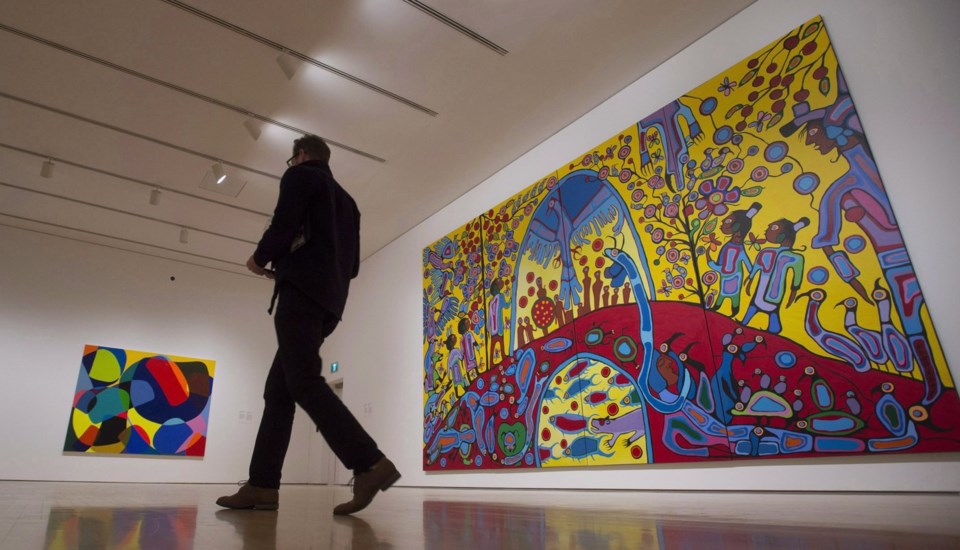More than a year after police in Ontario unravelled a massive art fraud involving the works of Norval Morrisseau, the late Indigenous artist's family and estate say they're still paying the price for the decades-long scheme.
In monetary terms, the fraud has greatly diminished the true value of Morrisseau's real works, his estate says. But the repercussions extend beyond the financial losses.
One of Morrisseau's children, Eugene Morrisseau, said he and his siblings have been grappling with questions about the wide-reaching fraud and how to wipe the stain it has left on their father's celebrated work.
"People were profiting off my dad's legacy, his artwork," he said in a recent interview.
"My sisters and my other brothers ... we always knew that something was going on."
Norval Morrisseau, also known as Copper Thunderbird, was a self-taught artist of Ojibwe ancestry and a trailblazer for contemporary Indigenous artists across Canada.
Allegations that an organized group in northern Ontario was creating and selling art under Morrisseau's name – and in his distinctive Woodland School of Art style – began to circulate long before his death in 2007.
In March 2023, Ontario Provincial Police and Thunder Bay police announced the arrests of eight people in connection with the fraud, although charges against at least one of the suspects have since been withdrawn.
Two Thunder Bay men who played key roles in the scheme, Gary Lamont and David Voss, have pleaded guilty to forgery-related charges.
Morrisseau's own nephew, Benjamin Morrisseau, was also among those charged. His next court appearance is scheduled in October, the Thunder Bay court said.
Police have said more than 1,000 allegedly fake paintings, prints and other artworks have been seized as part of their investigation, and some were sold for tens of thousands of dollars to unsuspecting people.
Cory Dingle, the executive director of the Norval Morrisseau estate, said the financial implications of the fraud are significant.
"The damage to our collection is about $30 million,” said Dingle. “The art fraud probably knocked us down about to one tenth of the value of what the art should be.”
In addition to the lost market value due to an unknown number of fake Morrisseau paintings still in circulation, Dingle said the estate has also spent hundreds of thousands of dollars in legal fees over the years.
Despite the art community’s low confidence in the authenticity of Morrisseau's pieces now thanks to the fraud, the family’s work to restore the artist's legacy is paying off. Dingle said paintings that have been validated have quadrupled in price in the last two years.
When the estate began verifying Morrisseau's paintings, the value was somewhere between $13 and $17 per square inch, he said. Two years later, they’re seeing record sale prices, with works on paper fetching up to $60 per square inch and a canvas painting recently selling for $87 per square inch.
Restoring faith in the authenticity of Morrisseau's work is something the family knows they can’t do alone. Dingle said those who have pleaded guilty in the case have an important role to play in helping the estate identify fakes.
"Working with us is one of the greatest things that we can do to heal the legacy, but also the entire Canadian art market," he said.
Eugene Morrisseau sees the reclamation of his father’s work as a starting point for repairing the harm done. His father taught him how to paint, he said, and those skills are now С����Ƶ passed on to his own children.
"I was taught by my father that each painting that (he) did, regardless of what it is, has a storyline to it," he said. "And it's a healing."
"I truly believe I could move forward and make things a lot positive."
The Morrisseau fakes may be part of what Dingle called "the largest art fraud case in global history," but he said this kind of organized forgery isn’t unique.
“Canada is a young country and we've only had 200 years of dealing in fine art,” the estate manager said.
"Other entities (like) Germany, France, they've had thousands of years, so they have better policies in place, better criminal code, better investigation services, that this doesn't really happen there.”
The Morrisseau estate said it has had discussions with both the RCMP and the federal Heritage Department about changes it would like to see to the Criminal Code and copyright law to prevent such massive frauds in the future. Such updates could benefit every Canadian artist, Dingle said.
"The world is watching."
This report by The Canadian Press was first published June 28, 2024.
Sheila Reid, The Canadian Press




